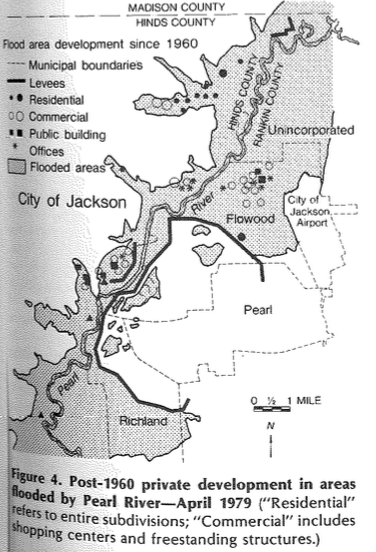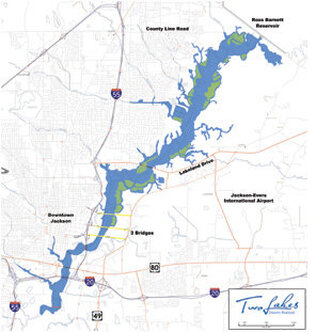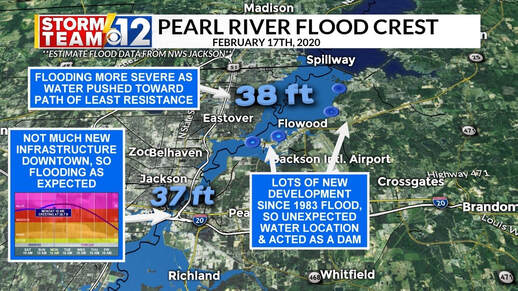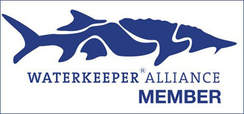|
THE BACKSTORY The Rankin-Hinds Pearl River Flood and Drainage Control District (Levee Board) was established in response to a 1961 flood and Congressional-authorization for a Rankin and Hinds county federal flood control project. In 1964, the US Army Corps of Engineers (USACE) began construction on a 1.5 mile levee on the Jackson side of the river, a 10.3 mile levee on the Rankin side, along with 5 miles of river straightening and channelization.
THE JACKSON FLOOD OF 1979 Less than a decade later, in April 1979, the City of Jackson and surrounding counties were hit with the flood of record, devastating communities and causing an estimated $500-$700 million in damages. Thousands of homes and businesses in the Jackson area were inundated in the flood stage that lasted from 10 to 14 days in some areas. Again, Congress gave authorization for the USACE to develop a comprehensive flood control plan for the Jackson metropolitan area. Now, 41 years after the flood of record, there is still no flood mitigation for the Jackson metro area. What happened? DEVELOPMENT AS FLOOD CONTROL Following the 1979 flood, numerous Pearl River flood control plans are developed by the USACE. In 1996, the USACE Feasibility Report, Flood Control, Pearl River Basin, Jackson Metropolitan Area, Mississippi recommends a system of flood walls and levees for flood control called the Comprehensive Levee Plan. This plan is ready for implementation and construction in 1996 but does not satisfy the development desires of the Levee Board and local developers. 17 years after the 1979 flood, the Levee Board rejects a feasible flood control plan.
Does the Levee Board give up on their development as flood control projects after that? Of course not.
Does the Levee Board give up on their development as flood control project then? Of course not.
In 2007, 28 years after the 1979 flood, the Levee Board again rejects the Comprehensive Levee Plan which has USACE approval and also Congressionally-authorized federal expenditure.
ENTER THE ONE LAKE PROJECT
PAVE PARADISE AND PUT UP A PARKING LOT Continued construction in the flood plain since the 1983 flood, the 2nd highest flood on record, made predicting flood stage impacts for the most recent Feb 2020 flood more difficult. During this high water event, the 3rd highest flood on record, Mike Word, Rankin County Emergency Management Director, stated that, because of development in the decades since the last major flood, "nobody can tell you where the 38-foot mark goes" and how widespread the flooding will be. He said that the amount of concrete and asphalt and sedimentation built up in the basin area over years will prevent water from soaking into the ground and could exacerbate flooding. "Nobody knows for sure how much the basin will hold." (Clarion Ledger, Feb 15, 2020). Governor Reeves commented at a MEMA press conference on Feb 16, "There were areas, due in large part to construction since 1983, there were areas that were receiving water that we anticipated would not receive water until they were at 38' level. All of these projections are just projections because, when you think about the amount of construction that's happened, particularly in the Jackson area since 1983, what we find is that there are certain areas where 36' feels like 38' and maybe there are going to be some areas where 38' feels like 39 or 39.5." Channel 12 Meteorologist, Jacob Lanier, reported that the Feb 2020 flood impacts differed from the forecasts because, " the flood projection maps we used are almost entirely based on the 1983 flood. Over the past 40 years, Rankin County has vastly changed. Going from mostly farm land to a very urbanized area along Lakeland & Old Fannin. This development, with concrete and landscaping, has made it harder for water to pass through. So it acted as a dam of sorts, pushing flood water up the path of least resistance into Northeast Jackson & Hanging Moss Creek. This turned a 36.7 ft river into a 38 ft river for those neighborhoods." "FLOOD CONTROL" HUBRIS In an Engineering News-Record article from Feb 2020, Keith Turner, Levee Board attorney, is quoted, "The approach (One Lake) would also widen the river and make way for commercial development." Sound familiar? The hubris that their "flood control" project would work and would thus enable us to continue to build more structures in the flood zone. We've learned nothing since 1961, when a false sense of security created by a "flood control" solution, led to a massive encroachment on the Pearl River flood plain. Jackson does not need a flood plain development project. The Jackson-metro area needs levee improvements, levee setbacks to remove the metro-area bottleneck and allow for an expanded flood plain, local green infrastructure projects to control flash flooding combined with local adoption and enforcement of appropriate restrictions on further floodplain development and select buyouts of properties that continually flood. As we wait for the Levee Board to push through another misguided Lake plan, construction in Hinds and Rankin county flood zones continues, putting more people and structures at risk for the next high water event.
|
AuthorPearl Riverkeeper is a licensed member of the Waterkeeper Alliance, the largest and fastest growing nonprofit solely focused on clean water. Archives
July 2024
Categories |
|
Ready to support our work for Clean Water and Healthy Rivers?
|
|




 RSS Feed
RSS Feed
